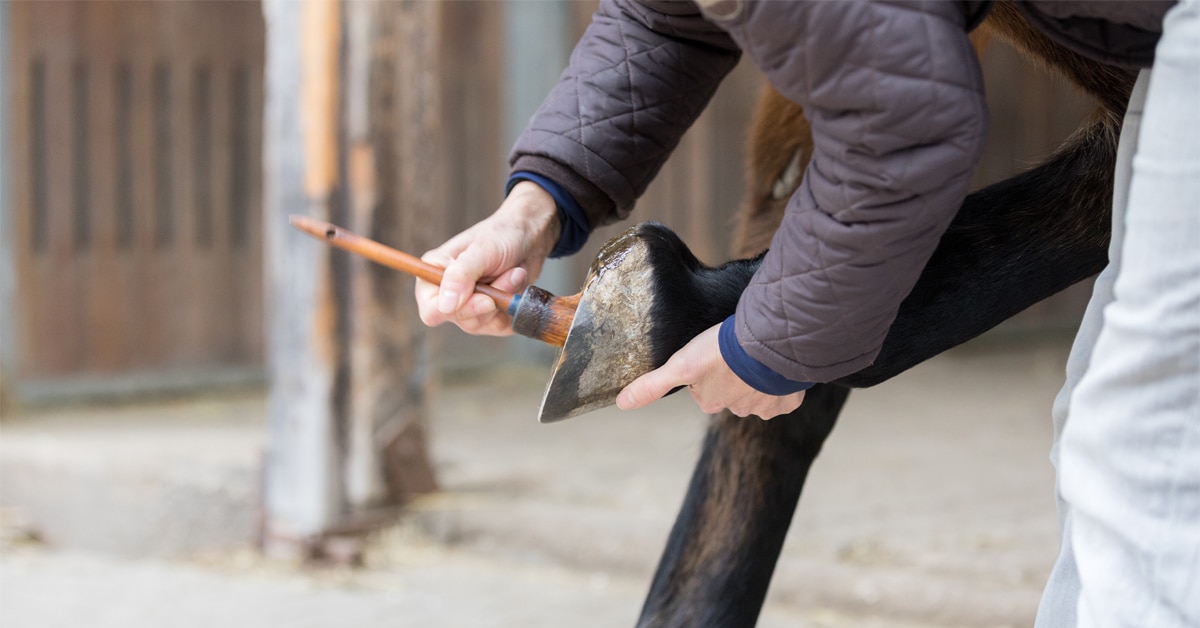It’s one of the most common hoof problems in horses, but it can be easily treated. The infection is so common in fact that according to a 2017 Dutch study of 942 randomly-selected horses, 45% had thrush.
What exactly is thrush?
Thrush is a bacterial or fungal infection that targets the center and grooves (sulci) of the frog of equines. There are different types of bacteria that cause the condition, with fusobacterium necrophorum being the most common. But while the type of bacteria or fungus may never be known in any given infection, why such organisms are able to cause infection is more important.
Why do horses get thrush?
Any horse or pony left to stand for long periods of time in wet footing will be prone to thrush infections. A major factor that contributes to thrush is where the horse lives. “Thrush is definitely one of the most common hoof problems in horses that live in a muddy environment outside,” says Kyle David, an Ontario-based farrier who travels to Wellington and Ocala throughout the winter show season. “They aren’t getting enough air in their feet and are standing in mud and manure too long.”
Basically, if a horse or pony lives outside 24/7 but the paddock or field and/or run-in shed has poor drainage or is a muddy mess during spring or any wet season, then that’s a breeding ground for bacteria that leads to thrush. But even horses who live in a stall can contract thrush, especially if the stall is damp or not cleaned regularly. However, the best-kept barns can still prove a suitable breeding ground for thrush-causing bacteria. Simply standing in its stall for long periods, or in its own manure or damp bedding, can also cause thrush to flare up in any horse. In this scenario, thrush is most likely to affect the hind feet.
Whether a horse gets thrush can also be a matter of conformation. Horses with long heels with deep, narrow frog sulci, coupled with moist and unclean stabling, are more prone than others.
Symptoms
Thrush is often easy to spot. It can exude a black and foul-smelling discharge in the affected areas of the frog. The heel can be very soft and squishy, and when pressure is applied to areas that appear infected, the horse may react or flinch with discomfort.
Treatment
Thrush is treated by first removing the necrotic (dead) tissue from the hoof, something that must be done by a farrier or veterinarian. “I cut away the dead, infected tissue so the hoof can dry out, so bacteria doesn’t keep spreading,” says David. He adds that once the infected tissue is gone, the blacksmith will clean out the center sulcus and back of the frog.
After your farrier has done his part, owners can also take steps to heal thrush and prevent it. There are products on the market such as Thrush Buster or Kopertox, as well as iodine-based hoof packing, or a homemade solution like vinegar and copper sulfate in a spray bottle can be applied several times a week. “Vinegar is drying agent, so it really gets in there,” says David. But one thing you should never use is bleach. “Bleach kills good and bad enzymes,” cautions David. “And it’s likely to make a horse sore; it’s simply too potent.”
David warns that thrush left too long and untreated can turn into white line disease, which is a bacterial infection that eats the white line membrane that holds the sensitive sole to the hoof wall. And if that happens, the farrier must cut away part of the hoof. “Opening it to the air kills the bacteria,” he says. “Thrush can also turn into canker, which becomes proud flesh that must be surgically removed. It’s very painful.”
You must also ensure your horses are kept in a dry, clean environment, and are up-to-date on their tetanus vaccine. The good news is that with proper treatment, most cases of thrush are resolved within 7-14 days.


